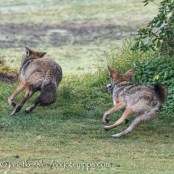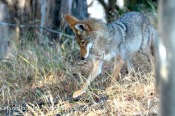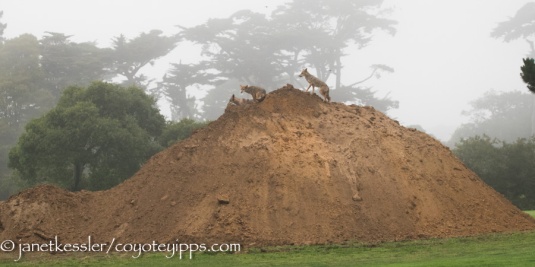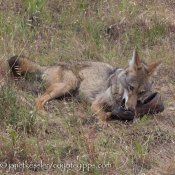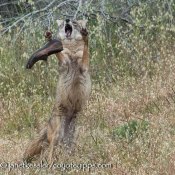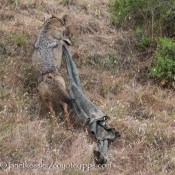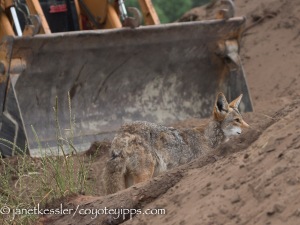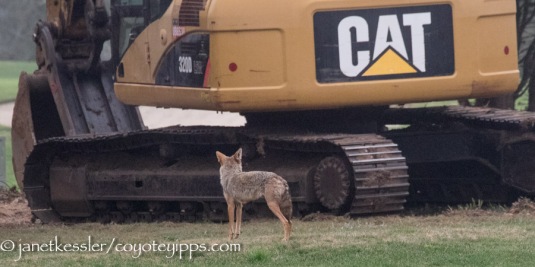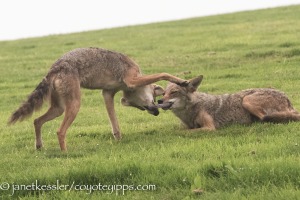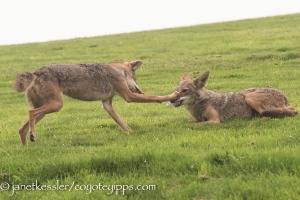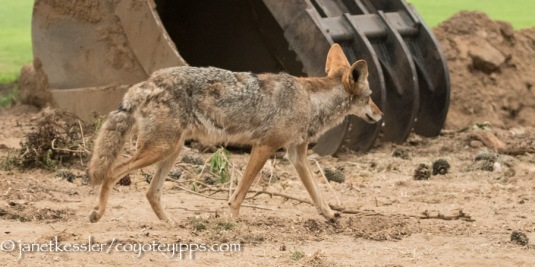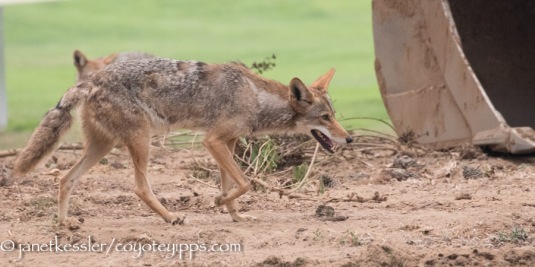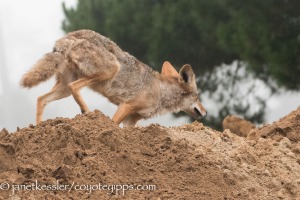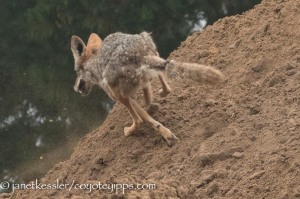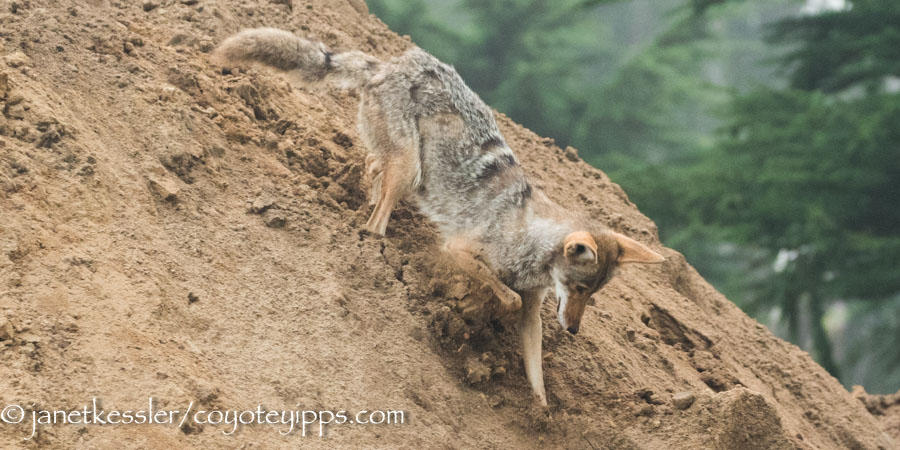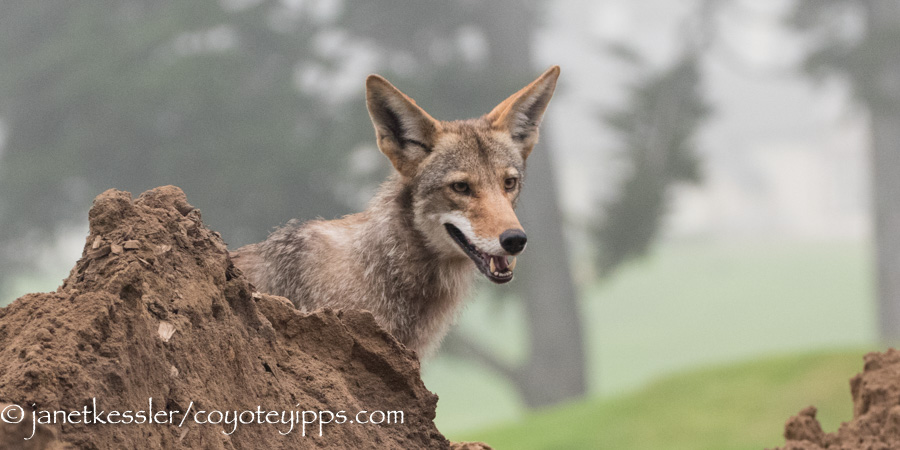Of course the coyotes play ! and wolves – and dogs – and all animals – they will find things to do for fun, and especially if they have no big family they live together with they will activate themselves, – they do not need to be nervous to do that ! They need an outlet for their curiosity and active brain, which is so important . Observing wild animals could teach the trainers something instead of getting hung up in theoretical and scientific blabbering.
Playing means activating the brain, and getting mental stimulation, and that is completely necessary for humans and animals for the development of the brain. It creates curiosity which is necessary, and the mental stimulation makes the growth of new brain cells, which in its turn helps them cope with problems and difficult situations in daily life.”
So, according to Turid, dogs’ nervousness and anxiety (the displacement behavior) is caused by them being forced to do something unnatural — there is no escape from the demands of their owners for them — so they calm themselves with repeat behaviors that don’t fit the situation. Coyotes are not constrained by the same circumstances of needing to please a demanding owner.
Another advisor, a 40-year-veteran wildlife behaviorist from one of the large wildlife organizations here in the city, also confirmed that *fight or flight* still rules supreme, and a little coyote will not put herself into a stressful situation if she can avoid it. Certainly an urban environment will create stresses for a little coyote — it does for all of us. I’m suggesting that this coyote’s playful behavior is driven much more by being lonely and bored than by stresses from the urban environment, based on my observations over many months.
Loneliness: In addition, coyotes often watch the world around them — maybe it’s entertaining: to sit in the distance and just watch. They get used to the goings-on, and to the dogs and people seen daily — habituated to it all — and then, again because loners are social animal, they may seek interactions and even action. They may attempt to actually *participate* on some level, say by approaching a dog simply to get noticed and to get a reaction. Some people have noted that they seemingly enjoy attention from onlookers — could it be that they actually might be *performing*? It must be very frustrating for them to be alone. These coyotes may feel a push-pull towards, and away from *the madding crowd*.
It is often hard for folks to stand back from such a situation, as has happened to this coyote. For a while, when she first appeared in the neighborhood, some dogs were allowed to interact with her, some people approached closer and closer, and some even fed her — some even throwing food from their car windows so that this coyote grew attracted to cars and to chasing cars in the street in hopes for a handout. By educating everyone about the need to stay aloof and apart — to *love her wildness* at a distance — and by stopping the feeding, I, with the help of most walkers in the area, lessened these interactions immeasurably. But it takes a village, and not everyone is on-board.
A period of increased energy. Last week, this little coyote’s playful activity suddenly picked-up. Her bouts of play with objects increased, she approached more dogs either with her play-bows or by dashing in-and-out around them. Chasing birds became a regular activity. And her chasing cars increased to several times a day (up from *zero to at-most a couple of times a week*). Her activity often begins with her excited pogo-stick-like leaping and then she sometimes takes off after a car, or towards a dog who has piqued her interest. Dog owners have been advised to simply keep walking on, and, if needed, to toss a small stone angrily towards her (not at her). It should be emphasized that everyone has noted that this coyote is not at all aggressive — she is just plain playful. In the case of the cars, she mostly has been running parallel to the road and not on it, but also she has been in the street, even reaching for the cars’ tires as if to bite them. A couple of onlookers informed me that chasing cars is seen commonly in South America by stray dogs and by dogs on farms, dogs who also are bored and looking for entertainment — they do it for thrills. The onlookers suggested that this might be an explanation for why the coyote was re-engaging with cars suddenly after she had stopped for a while — i.e., for the fun and thrill of it due to boredom! It’s worth considering because it sure looks like this to me, and these observations have been seconded by a veterinary behaviorists who knows canine body-language.
This coyote also has been engaging in more bouts of what we call *the zoomies*. Anyone who has a dog knows this crazy behavior: the dog races around, sometimes jumping on the furniture and sometimes in circles, full of energy, defiantly, daringly, a bit naughtily, as though testing you. Well, coyotes do this, too. I’ve repeatedly observed youngster coyotes do it, especially in the presence of their parents, exactly the way your dog does it! In the case of this lonely coyote, it was happening in-between other energetic activities, be it car chases, attempts to engage dogs, or gleeful play, as with a ball.
Coincidentally, during this sudden phase of increased playful and exuberant activity, a new coyote was sighted in the neighborhood — the first new coyote seen since our loner coyote appeared there over a year-and-a-half ago. Are these two things related? Let’s see! It could just be a coincidence. Another explanation comes from my wildlife behaviorist contact who told me that if you stop reinforcing a behavior with food, or ignore the behavior, the behavior will eventually extinguish, but that *extinction bursts* may occur before behaviors are totally extinguished — this is when the animal will try a little harder to get the reward she’s been given in the past by, say, running more after cars, or play-bowing more intensely to get the attention of dogs. Could this be what is going on?

approaching a dog

chasing a car
This increased activity level lasted several days, and then it plummeted during the next three days of almost full-time hunting, which pleased all of us no end. We’ll just have to keep a watch to see how this story develops. It might be of interest to everyone that her scat these days is loaded with fur (indicating she’s hunting) and/or is liquidy-dark (indicating high protein) and/or full of seeds (indicating she’s eating fruit). And I’ve documented her with apples, dead lizards, mice, gophers, a bird (yes, she even caught a bird and ate it) and even an opossum! Yay! Last November, when she spent most of her time panhandling, we almost never saw her hunt, and her scat was grainy and dog-like, instead of being twisted and rope-like and full of fur or seeds as it is these days!
-
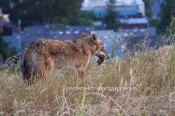
-
gopher
-

-
bird
-

-
opossum
-

-
mice
-

-
lizards
Generally, in all the parks where I observe here in San Francisco, be they loners or family groups, the coyotes are doing well. There was a fearful reaction to a coyote in the Presidio recently that was in the news. Trails were closed around the den where the incident happened to all dogs for the remainder of the pupping season: this protects coyotes, dogs, and people from having to deal with a similar encounter: it’s a perfect solution!
People are, on the whole, slowly learning about our coyotes. They are learning to live with, and to accept, them — and, best of all, to love them. My request to everyone is to love them at a distance — love their *wildness*. Don’t ever feed them, don’t be overtly friendly towards them, don’t approach them, and please keep your dogs away from them. If a coyote approaches you and your dog, simply tighten your leash and keep walking away without running — and keep walking away, dragging your dog if you have to. If needed, you should pick up a small stone and heave it angrily towards (again, not AT) the coyote to dissuade it from continuing to approach. It’s pupping season, and they have a job to do as family protectors. Their method of choice, if you’ve encroached on their space, is through *messaging*. Their message towards your dog could become very insistent: it could begin with little in-and-out darts towards your dog in an attempt to move the dog away, as cattle-dogs do, or standing their ground and displaying a menacing-looking Halloween-Cat pose — indeed scary looking — or even nipping your dog’s haunches to get it to leave. Please, just heed the message and move away from them quickly without running. As you leave, they may even follow: please just keep walking away.
For additional pertinent information, please see my presentation video, Coyotes As Neighbors: And visit other postings on this blog — it is full of information about coyote behavior here in San Francisco, which I’m sure is no different from elsewhere.
[*My postings are based on my own dedicated observations, as stated in the introduction to my blog].







